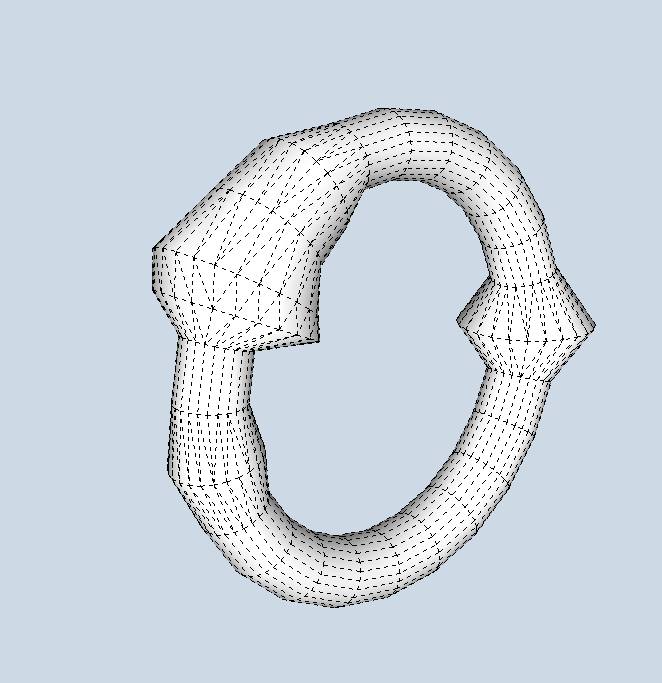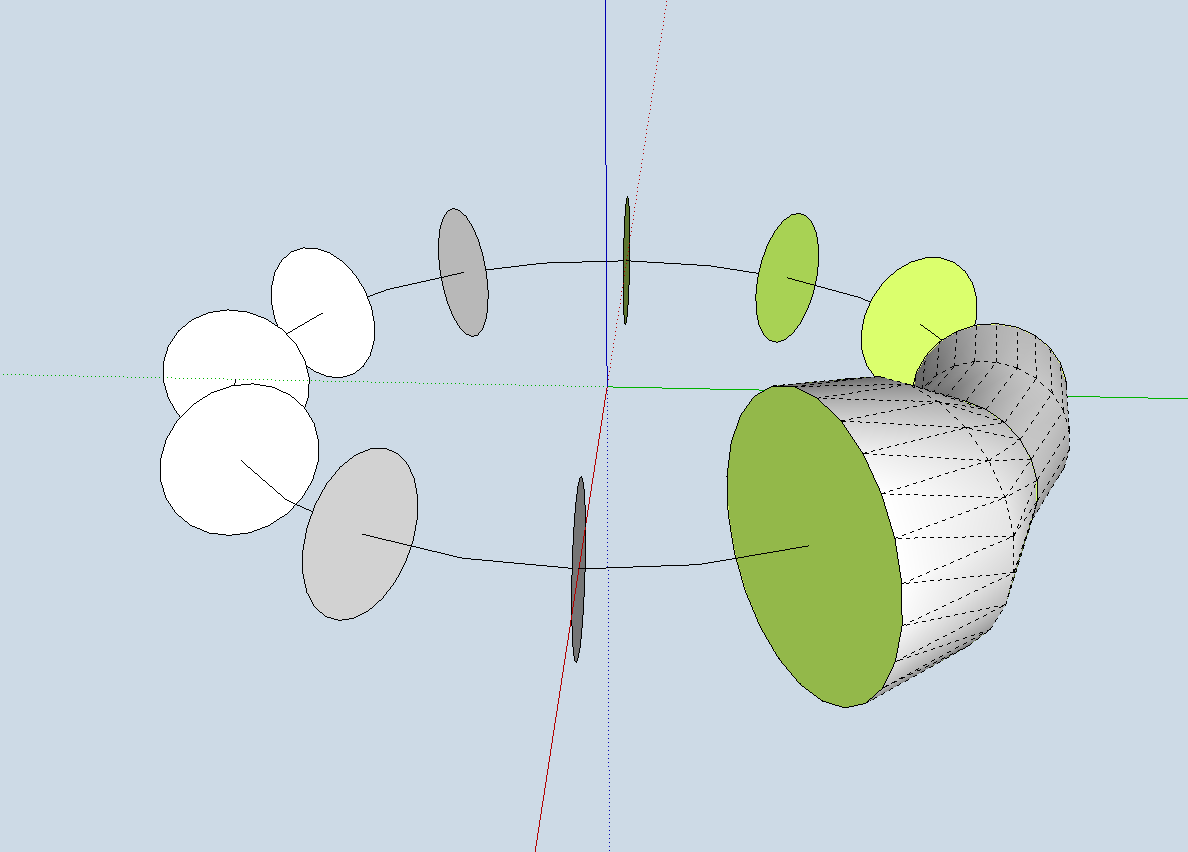Invitation to the SketchUcation collection
-
Those ball-and-claw feet look better. They are a bit of a challenge to do. It's something I want to do a blog post on when I have time to work out a good method that I can do and describe.
-
Here's a link to my latest model: The Governor Winthrop Secretary, featured in the 1957 book "Heirloom Furniture," by Franklin Gottschall. At one level, modeling a complex piece like this is akin to building a scale model of the Titanic out of toothpicks. A secretary has so many components, small bits, hidden elements. Modeling all that stuff is an exercise in self-satisfaction. However, this particular piece has some challenging elements: the round medallions on the gooseneck molding (done with a Curviloft plug-in), the flame finial, the carvings on the gallery doors and drawers (Curviloft again), and the ball-and-claw feet. Modeling those sharpens one's SketchUp skills considerably.
I'd appreciate feedback of all kinds. Let me know what you think of the model.
Many thanks,
dh -
Seems like a very nice job with most of the joinery sufficiently detailed to build it from the model. There is the odd small face missing here and there but that doesn't amount to anything serious at all.
I think the ball and claw feet could do with more work - the claws especially seem to lack definition (although not knowing this piece, they might be like that) but I am used to seeing knuckles on the talons which need to hug the balls more closely..
-
@chrisjk said:
Seems like a very nice job with most of the joinery sufficiently detailed to build it from the model. There is the odd small face missing here and there but that doesn't amount to anything serious at all.
I think the ball and claw feet could do with more work - the claws especially seem to lack definition (although not knowing this piece, they might be like that) but I am used to seeing knuckles on the talons which need to hug the balls more closely..
You're right that the feet could use some added definition. To make them, I take a profile of the foot, give it some thickness, copy and rotate the profile, then intersect the copies and remove the waste. After that, I extrude a ball and scale it until it fits the space in the foot (more or less). I was feeling pretty smug that I'd figured out how to take the modeling even that far. I've tried without success to figure out how to give the talons more definition. So I'm open to any suggestions. How would you do the feet?
Thanks,
dh -
David,
I think my approach would be to wrap a torus round a sphere, intersecting stuff as required to give me the necessary arc lengths, then to cheat a little (or a lot) and use the free training edition of this plugin ( http://www.tgi3d.com/index.php?Page=Download ) to thicken/thin the tube as required to make knuckles. I have not tried to give them any particular shape here - just illustrating the resizing possibilities of the plugin.

Other approaches might use Fredo's Tools on Surface to draw the lines for the talons directly on the ball, without cutting up a torus and then use pipe along path or tube along path to create the claws.
Again, one could employ a method like the one below where I made a radial array of circles (no need for a full circular array of course, then used the MOVE tool on the cardinal points to resize a couple of the circles then used Fredo's Curviloft to skin them.

-
@chrisjk said:
David,
I think my approach would be to wrap a torus round a sphere, intersecting stuff as required to give me the necessary arc lengths, then to cheat a little (or a lot) and use the free training edition of this plugin ( http://www.tgi3d.com/index.php?Page=Download ) to thicken/thin the tube as required to make knuckles. I have not tried to give them any particular shape here - just illustrating the resizing possibilities of the plugin.
[attachment=1:3dkznoc2]<!-- ia1 -->Knuckles.png<!-- ia1 -->[/attachment:3dkznoc2]Other approaches might use Fredo's Tools on Surface to draw the lines for the talons directly on the ball, without cutting up a torus and then use pipe along path or tube along path to create the claws.
Again, one could employ a method like the one below where I made a radial array of circles (no need for a full circular array of course, then used the MOVE tool on the cardinal points to resize a couple of the circles then used Fredo's Curviloft to skin them.
[attachment=0:3dkznoc2]<!-- ia0 -->Fredo way.png<!-- ia0 -->[/attachment:3dkznoc2]Both are interesting approaches. I'll have to give them a try. What I found, though, is that creating the talons isn't the biggest hurdle: It's blending the talons smoothly in with the thicker part of the leg and creating a convex area, known as the web, between the talons. Quite possibly, it might be simpler to refine the shape of the profile, adding curves for the knuckles, and proceed as I have before. It all depends on how one views the end-purpose of a SketchUp rendering, I think. For me, photorealistic reality isn't the aim; rather, I want to make a drawing that's complete enough to allow someone to build the piece for real. So, the SU version of the ball and claw foot gives the overall size and shape of the element; the final execution depends entirely on the woodcarver's skill, not mine.
dh -
Good point David. I might add getting two of them to look close enough to the same to be included on the same piece of furniture might be the bigger challenge than carving just one. I could only use ball and claw feet on a piece that is long enough so that you can't see both feet at the same time.

Nice work on the piece, by the way.
-
David, I quite agree about the end purpose for such a model. I too would not wish to spend a lot of time modelling the feet for the sake of a nicer looking SU model. As I said in my first post, your model is at a stage where it could be used for building the piece.
-
@chrisjk said:
David, I quite agree about the end purpose for such a model. I too would not wish to spend a lot of time modelling the feet for the sake of a nicer looking SU model. As I said in my first post, your model is at a stage where it could be used for building the piece.
Chris (and Dave R):
Thanks to you both for the compliments and advice. Here's another stab at the foot. Redrew the profile, adding pronounced angles for the knuckles. Then gave the profile thickness, rotated a copy, and used the Split tool in Solid Tools to remove the waste. Extruded the ball and scaled it to fit in the void between the talons. Aggressive softening of the edges at the end. It's better (Solid Tools makes fast work of it), but still not exact. I'll keep at it.
dh
-
My first complex SketchUp designed from scratch and then built...
http://sketchup.google.com/3dwarehouse/details?mid=1bf8e2a98e2ab4316bdc8a5dbe375ecf -
Pretty nice model, Stormking. I found a few small things that could be changed/cleaned up but overall it's pretty good. Do you have pictures of the actually unit you built? Could you share them?
-
A couple of additions:
An American Empire-style chair with scroll arms, from "American Furniture Treasures." And a Hepplewhite drawer pull based on a design from Whitechapel Ltd. Both models are also in the 3D warehouse.
As always, thanks to Dave Richards for casting his careful eye over the models and finding things that need to be fixed.
Also as always, I'd appreciate any kind of feedback.
Thanks,
David
-
Having done some chairs, it was obviously time for me to make a table. You can see it in the 3D warehouse by following this link:
The file is too large (5+MB) to post here directly.
As always, I'd appreciate feedback of all types.
Best,
david -
It is very challenging to design or sketch a chair. This will build and enhance our artistic ability. In addition with that, I am very interested to see the American empire chair. I hope you will post it here.
-
Dear Karen05,
The chair is here. Look up a couple of entries to my post of February 12. You can also find the chair model on the 3D Warehouse by following this link:Let me know what you think of the piece.
Thanks,
David -
A gate I made originally designed by a wonderful architect in Santa Fe in the 1930's.
-
Hi Frank,
That's a nice looking gate. Very sturdy, too. It is also an excellent illustration of how components can be used to reduce file size. I spent a few minutes fixing your model and reduced the file size by about 83%.
Thanks for posting the link to it.
-
Thanks David. I wasn't even thinking along the size line when I submitted it. I went back and did the same thing on the model in the warehouse.
-
The link doesn't work anymore.
-
Here is a tool cabinet that I drew up for Popular Woodworking magazine. http://sketchup.google.com/3dwarehouse/details?mid=c2ac91973d449b18738e43095496b061&prevstart=0
Advertisement







